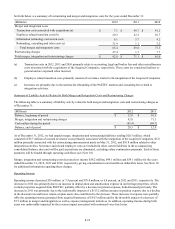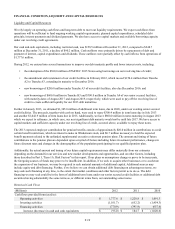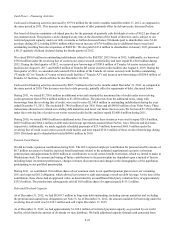Windstream 2012 Annual Report Download - page 113
Download and view the complete annual report
Please find page 113 of the 2012 Windstream annual report below. You can navigate through the pages in the report by either clicking on the pages listed below, or by using the keyword search tool below to find specific information within the annual report.
F-15
For 2013, our annualized effective income tax rate is expected to range between 37.0 percent and 38.0 percent, excluding one-
time discrete items. Changes in the relative profitability of our business, as well as recent and proposed changes to federal and
state tax laws may cause the rate to change from historical rates. See Note 12, “Income Taxes”, to the accompanying
consolidated financial statements for further discussion of income tax expense and deferred taxes.
Discontinued Operations, net of tax
The operating results of the energy business acquired as part of PAETEC, which sells electricity to business and residential
customers, primarily in certain geographic regions in New York state, as a competitive electricity supplier, have been separately
presented as discontinued operations in the accompanying consolidated statements of income. On June 15, 2012, we completed
the sale of the energy business. See Note 16 for additional information.
Regulatory Matters
We are subject to regulatory oversight by the Federal Communications Commission ("FCC") for particular interstate matters
and state public utility commissions ("PUCs") for certain intrastate matters. We are also subject to various federal and state
statutes that direct such regulations. We actively monitor and participate in proceedings at the FCC and PUCs and engage
federal and state legislatures on matters of importance to us.
Communications services providers are regulated differently depending primarily upon the network technology used to deliver
the service. We believe this regulatory approach impedes market-based competition in areas where service providers using
different technologies exchange telecommunications traffic and compete for customers.
From time to time federal and state legislation is introduced dealing with various matters that could affect our business. Most
proposed legislation of this type never becomes law. It is difficult to predict what kind of legislation, if any, may be introduced
and ultimately become law. We strongly support the modernization of the nation's telecommunications laws.
Federal Regulation and Legislation
Intercarrier Compensation and USF Reform
On November 18, 2011, the FCC released an order ("the Order") that established a framework for reform of the intercarrier
compensation system and the federal USF. The Order included two primary provisions:
• the elimination of terminating switched access rates and other per-minute terminating charges between service
providers by 2018 through annual reductions in the rates, mitigated in some cases by two recovery mechanisms; and
• the provision of USF support for voice and broadband services.
In reforming the USF, the Order established the Connect America Fund, which included a short term ("CAF Phase 1") and a
longer term ("CAF Phase 2") framework. CAF Phase 1 provides for continued legacy USF funding frozen at 2011 levels as
well as the opportunity for incremental broadband funding to a number of unserved locations, limited to $775 per unserved
location. As a result of our aggressive broadband deployment to date, we had very few unserved locations remaining in our
service areas for which $775 in incremental support would make broadband deployment economical. On July 24, 2012, we
elected to accept approximately $0.7 million of the $60.4 million in incremental support allocated to us for 2012. In addition,
we filed a waiver request seeking to modify certain CAF Phase 1 requirements, which would enable us to accept the remaining
$59.7 million to expand our broadband footprint. The waiver request is still pending. The FCC is currently considering
potential modifications to the rules governing CAF Phase 1 incremental support for 2013 that may enable us to accept more of
the funding allocated to us, which may include funding carried over from 2012. The FCC is also weighing a separate proposal
to forego an additional round of CAF Phase 1 incremental support in 2013 and add all remaining funds from CAF Phase 1 to
the budget for CAF Phase 2.
The FCC is working to establish rules for CAF Phase 2 funding based on a forward-looking cost model to further extend
broadband to high-cost areas. The development of this model was not completed by the end of 2012 as originally scheduled by
the FCC. Until the implementation of CAF Phase 2 is complete, our annual USF funding will continue to be frozen at 2011
levels, but we will be required to use one-third of frozen legacy support to operate and build broadband networks beginning in
2013. Based on current expenditures, we expect to comply with these additional funding conditions in 2013. In 2014, this
condition will apply to two-thirds of frozen legacy support and in 2015, it will increase to 100 percent.
























